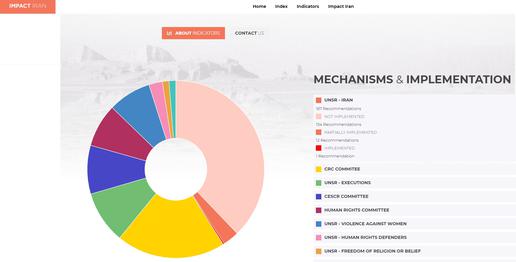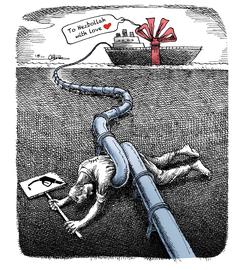A new online database mapping out nearly 20 years of human rights warnings issued to the Islamic Republic of Iran – and how the regime responded – has gone live.
For the first time, the Iran Rights Index (IRIx) catalogues each of the 407 recommendations made to Iran by three United Nations Treaty bodies and six UN Special Procedures, from 1993 to 2000. Using a tailored set of metrics, it also evaluates how far the regime has come.
The project was unveiled at an online event on Tuesday that explored how data and databases, compiled by Iranians and activists in the diaspora, could help push the Islamic Republic toward a greater degree of accountability.
Other organizations presenting their work – respectively covering the victims and perpetrators of violations in Iran – were the Abdorrahman Boroumand Center for Human Rights in Iran and Human Rights Activists in Iran (HRA), best known for its news agency, HRANA.
The talk was also attended by Javaid Rehman, the UN’s Special Rapporteur for Human Rights in Iran. He told those present: “With the deficiencies of the national and international orders, and obstacles to a response to atrocities, the timely use of data for proving accountability is still a dream.
“But over the last few decades, we’ve seen impressive examples of civil society endeavours in creating space for accountability where there has been no political will for it... I humbly praise the work of human rights defenders who operate in this challenging environment, despite all the risks and barriers.”
Monitoring Compliance
The IRIx database was built by Impact Iran, a coalition of human rights-focused NGOs. Advocacy officer Azadeh Pourzand said: “Iran has received hundreds of recommendations from various mechanisms, and continues to receive at least a dozen a year. We made it our mission a couple of years ago to create a comprehensive database.”
Users can search the guidance by source – from such bodies as the UN Arbitrary Detention Committee, the Special Rapporteur on Violence Against Women, or Committee on the Rights of the Child – or by the demographic group covered in the guidance, such as civil society, people with disabilities. or prisoners.
Based on Impact Iran’s bespoke indicators, the database then shows whether the necessary measures have been fully, partially or not at all executed by the Islamic Republic. Where new laws have been enacted in Iran, IRIx appraises whether they went far enough, and how far they have actually been implemented on the ground.
One “dispiriting” early takeaway, Pourzand said, was “the number of repetitions we see in the recommendations Iran has received throughout the years... It shows there’s so much work that needs to be done by the Islamic Republic.”
IRIx creators were also hampered by the lack of transparent data emanating from the Islamic Republic. News stories, political speeches and dispatches from NGOs on issues like the death penalty, Pourzand said, helped to provide “pieces of the puzzles”.
She added: “We hope states can use IRIx to inform their bilateral rights relations [with Iran]. And we also hope that NGOs, human rights organizations can refer to the framework we’ve developed to better inform their documentation and advocacy efforts.”
The Other Pieces of Iran’s Human Rights Puzzle
HRA launched its own database, Spreading Justice, in March this year. The website holds information on some 250 regime figures, from Revolutionary Court justices to intelligence agents to clerics, who are known to have committed human rights violations in Iran.
Users can search by name, sector or the type of violation, going back 15 years. Each violator is profiled in a downloadable report that includes a detailed narrative, supporting documents, reports and media, detailed legal reviews, and any named victims of their crimes.
Senior advocacy coordinator Skylar Thompson said: “After years of reporting and seeing little to no accountability, we started looking at ways in which our efforts could shine a light on those responsible and shrink the accountability gap.”
Spreading Justice, she said, was a “living, breathing tool” that would be constantly updated with new profiles as new cases emerged, allowing concrete action to potentially be taken against the perpetrators in future. HRA is also holding additional, more sensitive information on file that interested parties can request access to.
The audience on Tuesday also heard from veteran human rights campaigner Roya Boroumand, founder of the Abdorrahman Boroumand Center for Human Rights in Iran (ABC). She reflected on ABC’s own database, Omid (Hope), a memorial project set up in 2002 and published in 2005, cataloguing both the victims of human rights abuses under the Islamic Republic since 1979 and under the previous regime since 1948.
“In 1979, Iran missed the transition to a democracy based on rule of law,” Boroumand said. “There was a lack of awareness among the population of human rights violations. The vengeful, arbitrary and summary nature of revolutionary tribunals established the system.”
The Omid database now holds records for more than 25,500 victims of state violence in Iran. It tells the ever-incomplete stories of people of all backgrounds and sectors of society, regardless of their political orientation. Each has their own page in the virtual memorial, with information on what befell them drawn from statements issued by Iran’s authorities, official media, reports by human rights organizations and personal testimonies. “First and foremost,” Boroumand said, “it’s an attempt to address the frustration and helplessness of victims of decades of violence, by giving them agency to join a collective truth-telling effort.”
Omid also contains a welter of information about victims of Iran’s 1988 prison massacre, for which a former Gohardasht Prison official, Hamid Nouri, is now standing trial in Sweden. Ten years ago ABC commissioned an expert report by an international judge, Geoffrey Robertson QC, which established the contours of what had happened in 1988 – drawing on many of ABC’s collected testimonies – so as to lay out what types of crime had occurred, and who was culpable. The final 108-page report has been repeatedly cited at Nouri’s trial in Stockholm over the past month.
Boroumand said the Nouri trial had proved “the importance of documenting, regardless of the immediate outcome and the possible legal recourse.” She added: “Often, we felt engagement with [Iranian] government actors had meant an effort not to alienate the interlocutors by talking about the truth. This is not a good approach. This approach has not helped.
“When you confront them with the truth – and it can be a very polite, positive confrontation – it makes the conversation real. I hope the Nouri trial also the beginning of a new, reality-based approach.”
visit the accountability section
In this section of Iran Wire, you can contact the officials and launch your campaign for various problems



























comments